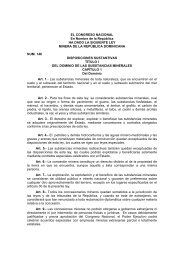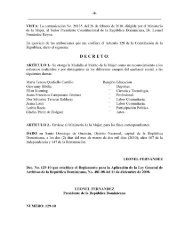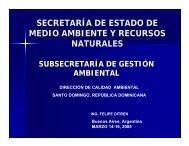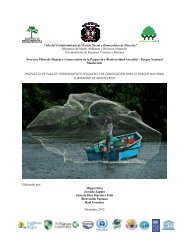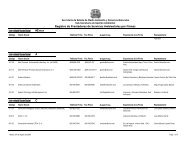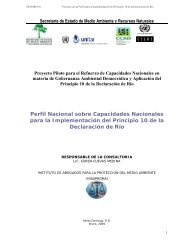CAMBIO CLIMATICO
CAMBIO CLIMATICO
CAMBIO CLIMATICO
Create successful ePaper yourself
Turn your PDF publications into a flip-book with our unique Google optimized e-Paper software.
REPÚBLICA DOMINICANA 2003<br />
average, from 1 to 3° C higher than what the temperature<br />
normally is during this period.<br />
Regarding the Atlantic slope area, the average<br />
for the year 2010 (25.997 °C) is less than the<br />
base value (27.008 °C). This is inconsistent with<br />
the pattern of increase and is an example of the<br />
bias introduced by the correlation, which is narrowly<br />
interrelated with the values of the correlation<br />
coefficient between 0.70 and 0.84. There<br />
is also a high degree of correlation between the<br />
temperature of the air and the water in the<br />
Caribbean and Atlantic regions, both of which<br />
have similar seasonal variations, with natural<br />
differences being that the water remains at a<br />
higher temperature for a longer time from the<br />
height of the summer, due to the thermal inertia<br />
of the ocean.<br />
The adaptation measures in this sector are targeted<br />
to avoid and/or mitigate the changes needed to alleviate<br />
and evaluate in the shortest possible time the<br />
expected impacts on the Dominican coasts based on<br />
the vulnerability of the different sectors, and to<br />
develop strategies with adaptation measures that<br />
contribute not only to mitigating future impacts, but<br />
also to resolving the current impacts that reduce the<br />
vulnerability of the coastal environment.<br />
The recommendations for mitigating these<br />
impacts include measures such as the following:<br />
• Restore and rehabilitate the wetlands areas<br />
and coasts to allow the natural flooding of<br />
large land areas and to maintain water balances.<br />
• Eliminate the current pressures that reduce<br />
the capacity of the coastal ecosystems to<br />
respond to climate change, particularly all<br />
forms of domestic and industrial pollution.<br />
• Avoid the removal of plants and protect the<br />
biological diversity in order to maintain and<br />
increase the capacity for recovery and adaptation<br />
of the wetlands ecosystems so that they<br />
can continue to provide important services<br />
under varied climate conditions.<br />
• Maintaining the flow of rivers, including the<br />
period of low water, also represents an important<br />
approach in the maintenance of the wetlands<br />
systems, etc.<br />
1.4.3 Agricultural Sector<br />
The ongoing climate change represents a potential<br />
threat for agricultural production and the<br />
very existence of the forests in the tropical zone<br />
of the planet (UKMO, 1998; IPCC, 1996).<br />
The Potential Biomass Density (PBD) for<br />
Dominican forests could not be calculated<br />
because the necessary topographic and soil information<br />
was not available for this report. To evaluate<br />
climate impact on agricultural crops annually,<br />
the WOFOST 4.1 biophysical model was used.<br />
On the other hand, the impact parameters analyzed<br />
for irrigation crops were potential yield,<br />
such as water consumption, and the quantity of<br />
nutrients required to produce these yields. For<br />
irrigation crops, the model was run 30 times for<br />
each date of planting, in the base climate and in<br />
future climatic scenarios, with and without taking<br />
into account the possible CO 2 fertilization effect.<br />
This study included only the biophysical impacts<br />
of the first order of climate change concerning<br />
agriculture and forests in the Dominican<br />
Republic, and not those of a higher order<br />
(Rivero, 2001). This preliminary evaluation is,<br />
therefore, in a certain sense, analogous to the<br />
rapid evaluation conducted in Cuba (Rivero et al,<br />
1998), and should be expanded and completed<br />
in the future by Dominican specialists.<br />
1.4.3.a) Forests and Forest Formations<br />
The (potential) net primary productivity (NPP)<br />
of Dominican forests under current climate conditions<br />
denotes a very high productivity in the<br />
geographical zone coinciding with the highest<br />
amount of precipitation. However, there are<br />
areas of very low NPP located to the south of the<br />
Central Mountain Range. The NPP of the forest<br />
formations will experience momentous changes<br />
46


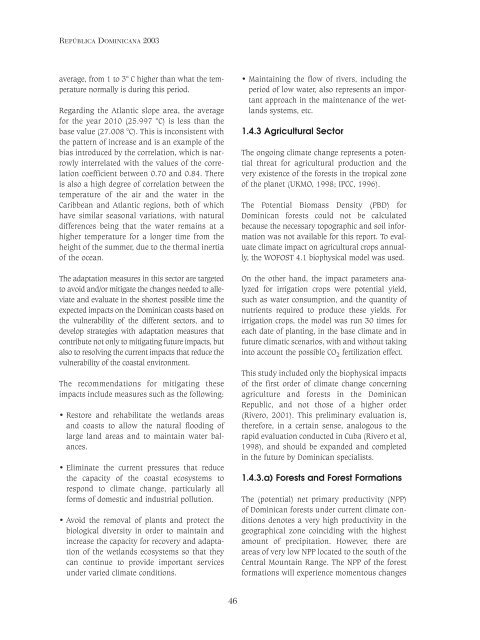
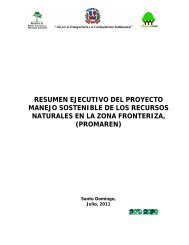
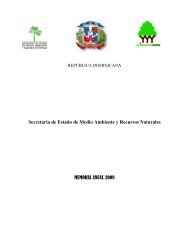

![Documento de trabajo del grupo G-77[1] EconomÃa verde en el ...](https://img.yumpu.com/50859069/1/190x245/documento-de-trabajo-del-grupo-g-771-economa-a-verde-en-el-.jpg?quality=85)




